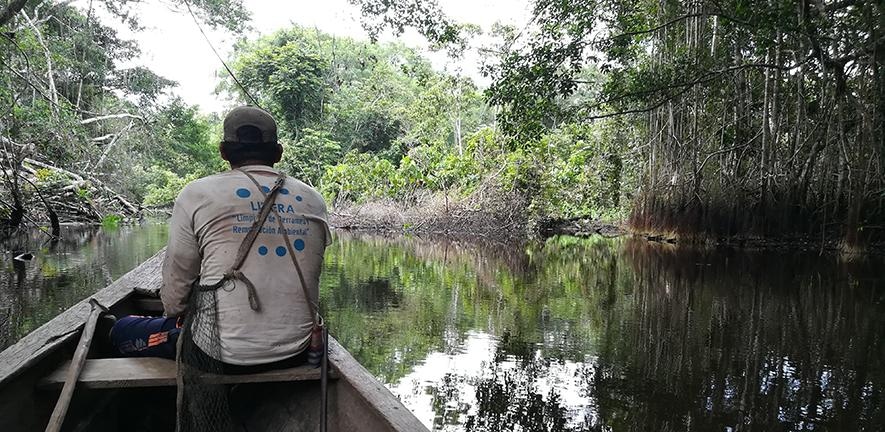May 22 2019
A team of UK and Peruvian scientists have conducted the first comprehensive survey of how rural communities interact with peatlands in the Peruvian Amazon, a landscape that is one of the world’s largest stores of carbon.
 (Image credit: University of Cambridge)
(Image credit: University of Cambridge)
Tropical peatlands, located in Africa, Southeast Asia, South and Central America, play a vital and, thus far, disparaged role for the global climate system because of their ability to process and store huge amounts of carbon. Peat constitutes just 3% of the land’s surface around the world; however, it stores one-third of the Earth’s soil carbon.
The peatlands are less densely populated but indigenous and Spanish-descended populations have been living there for centuries. Still, the majority of communities can be reached only by boat.
Currently, a research team headed by a geographer at the University of Cambridge has conducted the first comprehensive study of how local communities look at and interact with these significant landscapes. Their outcomes have been published in the journal Biological Conservation.
The UK researchers together with colleagues from Peru surveyed two rural Amazonian communities: a small indigenous community from the Urarina nation and a larger mestizo community of varied cultural heritage. Although other investigators have been engaging with these communities for years, the study was the first to connect with their perspectives on the uses, management, cultural importance, and conservation of peatlands in the Peruvian Amazon.
These communities are very remote, and very little is known about their relationship with the peatlands. People living in remote and rural communities are shaping ecosystem management in their surroundings, but their perspectives are rarely heard in wider debates.
Christopher Schulz, Study First Author, Department of Geography, University of Cambridge
Members from both communities are mostly subsistence farmers, even though the mestizo community has some small shops and carries out some trade outside their community. Both communities, together with others based in the remote, largely unfamiliar peatlands, are mostly not regarded by the central government.
The peatlands are the habitat for several guardian spirits, like the Baainu, famous among the Urarina people, who is supposed to mislead people to lose their way. In addition, it houses several “dead lakes” that are culturally prohibited among the mestizo community, who suppose that guardian spirits can bring about thunderstorms if the lakes are approached. The mestizo community is also scared that going near to the dead lakes could lead to getting attacked by caimans or anacondas, or getting immersed into the soft ground.
Beyond the lakes, the landscape is taken over by palm trees, which grow well even with the wet, poor peatland soils, and are a vital food source for animals and for the Urarina and mestizo communities. The palm fruit and hearts are reaped by both communities for personal consumption as well as for selling it to traveling traders. Moreover, both communities utilize the wood and timber, although it is of inferior quality when compared to those of trees from non-peatland areas. In the Urarina community, the palm fronds are also employed in roofing; however, these are progressively being replaced more by corrugated metal roofs.
Besides their practical applications, palms also have a spiritual and cultural purpose. In the Urarina community, fibers obtained from the aguaje palm are employed for textile production. The Urarina creation myth includes an element in which a wise woman is recognized by her skill to weave aguaje fibers into cloth.
Provided the significance of the palm trees to both communities, it has resulted in concerns of conservation. The trees are presently cut down in order to reap the aguaje fruits.
“Both communities recognize that they have an effect on palm tree populations, but they don’t have any specific conservation strategies as such,” stated Schulz. “In the past, different groups have introduced equipment for climbing the palms instead of felling them, so that’s a simple conservation initiative that could be supported.”
The knowledge accumulated by the Urarina about these permanently wet ecosystems is the best guarantee for their conservation.
Manuel Martín Brañas, Study Co-Author, Peruvian Amazon Research Institute (IIAP)
Before the scientific community had discovered the importance of these ecosystems for the climatic balance of the planet, the Urarina were already using them in an efficient and sustainable way, they classified them, gave them names, and they had established social controls for not damaging them.
Cecilia Núñez Pérez, Study Co-Author, Peruvian Amazon Research Institute (IIAP)
Further research will examine the possible role played by conservation NGOs and other relevant stakeholders or institutions in protecting the peatland regions, and ecological surveys will be carried out to gain better insights into the ecological composition of the peatland vegetation.
The work was partly funded by the Natural Environment Research Council (NERC).